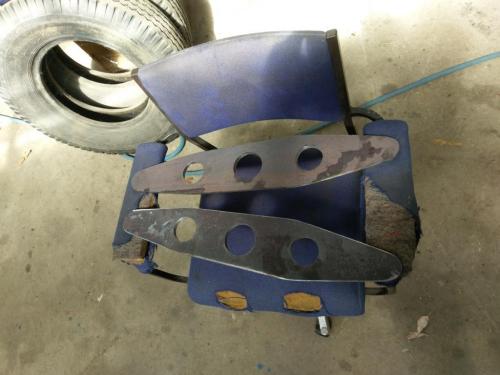G'day all, haven't been around for a while- we were without internet at home for over a month. Long story. I have managed to make a little progress on the loader but not nearly as much as I would have liked.
Made and attached the fish plates for the stress point over the lift ram attachment. Pretty much the same as the other end- 600mm long 10mm thick- matching plates to the inside and outside of the arms at this end as there is no cross member in the way.


I've been working on the line-boring setup as time permits. got a length of 25mm bright shaft, cross drilled in a couple of places for a 3/8 round HSS cutter and a grub screw to locate same. Four flanged housings with self-aligning bearings will carry the shaft.

I've been musing over how best to provide power and feed to the line-boring shaft and after many various setups in my head, finally settled on using the lathe for both power and feed. I'll set up the steel bench behind the lathe and take power from the back end of the spindle, using a tractor PTO shaft to connect to the boring shaft. The PTO shaft sliding joint will allow for the necessary longitudinal movement of the shaft for the boring operation, and I can link the shaft to the apron of the lathe to power the feed (that will become clearer as i progress with the setup).
I've made a PTO output for the spindle, this will be held in the chuck and extend out the back of the spindle. I had a suitable length of 38.5mm round stock, turned one end to the major diameter of the splines, with an extended nose turned to the minor diameter for holding in the dividing head and touching-off with the cutter,

There is a proper cutter for this job that takes out the space between the splines in one pass, but I don't have it (I checked). So I used a pair of cutters with a spacer, the thickness of the spline, between. I didn't have a pair of cutters or a spacer the right thickness either, but the surface grinder took care of that. I found two cutters of the same nominal size, ground them to identical thickness so that they would be on centre after touching-off on both sides of the workpiece, then sharpened them both to the same diameter. I had to take over .025" off every tooth on one of the cutters to bring it down to the diameter of the other. Took ages but I got there.
The shaft is too long to use the tailstock with the dividing head, so I set up a v-block and clamp to hold the back end against the cutting forces.

Using the mill in horizontal mode for the first time since the Bridgeport conversion. One pass with the cutter pair for each of the 6 splines. I was too lazy to take the vises off the mill, they are not involved in this job.


this leaves a ridge down the centre between the splines that has to be milled off. The PTO shaft specs show a minor diameter, but apparently this is not important as the female engages on the major diameter, so the shaft can be milled flat between the splines. I had a cutter of appropriate thickness to knock off the ridge, indexed the DH half way between the splines and ran it through.


The long nose was taken off in the bandsaw. I'll face the end in the lathe (have the blank for the other end of the job in there at present).

Due to the way this job had to be held in the DH, I was unable to check the splines for fit until the extension was cut off, so there was no opportunity to tweak the fit in the mill. I have one rusty old PTO shaft that won't slide on and one new PTO socket that goes on nicely. I'll be using the long driveshaft off my slasher which is almost new, haven't checked it for fit yet. Hopefully it's just the rust in the other that prevents it going on- it's been lying outside for years- otherwise a bit of file work may be necessary.
The driven-end adaptor blank is in the lathe at present, it'll be bored at the back end to fit on the 25mm boring bar. Waiting for a reamer to arrive to finish the bore so I can take it to the mill to spline it. That one will be done using the DH tailstock, with just enough nose to touch-off for cutter depth.
Lathe (n); a machine tool used in the production of milling machine components.
Milling Machine (n); a machine tool used in the production of lathe components.






